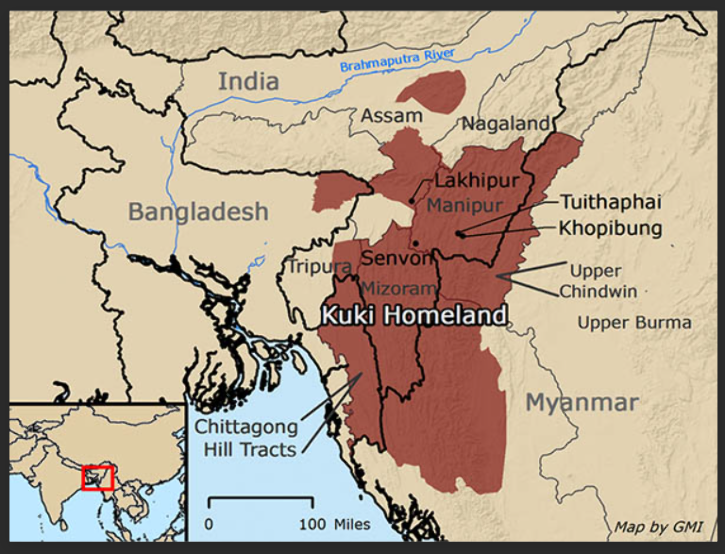- Home
- Prelims
- Mains
- Current Affairs
- Study Materials
- Test Series
 EDITORIALS & ARTICLES
EDITORIALS & ARTICLES
Kuki Ethnic Nationalism
The demand for a separate Kukiland dates back to the late 1980s, when the first and largest of the Kuki-Zomi insurgent groups, the Kuki National Organisation (KNO), came into being. The demand has surfaced periodically ever since. In 2012, it became increasingly clear that the demand for a separate Telangana state would be accepted. At that time, an organisation called the Kuki State Demand Committee (KSDC) announced a movement for Kukiland.
- Demand
- The KSDC claimed 12,958 sq km, more than 60% of Manipur’s 22,000 sq km area, for Kukis and Kukiland.
- The territory of Kukiland included:
- the Sadar Hills (which surround the Imphal valley on three sides),
- the Kuki-dominated Churachandpur district, Chandel, which has a mix of Kuki and Naga populations, and
- parts of Naga-dominated Tamenglong and Ukhrul.
- Unlike the Naga demand for a separate country, Kukis are only seeking a separate state within the Indian Union.

Reasons behind the demand of Kukiland
- Historical
- The KSDC and sections of the Kuki-Zomi community have maintained that the tribal areas are yet to be a part of the Indian Union.
- They have contended that after the defeat of the king of Manipur in the 1891 Anglo-Manipur war, the kingdom became a British protectorate.
- However,the lands of the Kuki-Zomi were not part of the agreement.
- The idea of the Zale’n-gam, or ‘land of freedom’
- As per the Kuki-Zomi people, the Kuki Zale’n-gam sprawled across a large part of India’s Northeast and contiguous areas in present day Myanmar.
- Under the Treaty of 1834, the British handed over a significant chunk of this land to Burma to appease the Ava or Burmese king.
- According to the KNO, the Zale’n-gam included the area up to the Chindwin River in Myanmar.
- It covered the bordering regions of India, the areas around the Nantalit river in northern Myanmar, and stretched to the Chin state in the south.
- In India, the Kuki homeland included:
- the hill districts of Manipur, including the Naga areas, Kanjang, Akhen, Phek, and parts of Dimapur in Nagaland,
- Karbi-Anglong, North Cachar Hills, and Halflong in Assam, and Tripura, as well as parts of the Chittagong Hill Tracts in Bangladesh.
- Over the years though, this imagination of the homeland has shrunk to that of a state created out of the hill areas of Manipur, including those dominated by the Naga tribes.
- Identity and Cultural Preservation
- Manipur has a diverse ethnic population with Meitis controlling the Valley, Nagas on the surrounding hills and Kukis interspersed in between.
- The Kuki community has a distinct cultural identity, language, and history.
- The Kukis are Manipur’s third major ethnic group, after the majority Meitei Hindus and the Naga tribes.
- Hence, the community is demanding a separate state to preserve their identity and culture.
- Clash with Naga group
- The community has alleged that Naga insurgent groups have been attempting to grab Kuki lands for decades.
- During the Naga-Kuki clashes of 1993 more than 1,000 Kukis were killed, and many times that number were displaced.
- Socio-economic development
- Some Kuki groups believe that a separate state would provide them with political power and control over their own resources which are largely controlled by the Meiteis.
- This would allow them to achieve socio-economic development.
- Administrative Autonomy:
- Kuki organizations argue that a separate state would enable them to make decisions on matters such as governance, law and order etc., based on their specific needs and aspirations.
- Recent violence in Manipur
- Days after the tribal Kuki community clashed with the Meiteis on May 3, the demand for separate Kuki State has resurfaced.
- A ‘tribal solidarity march’ was organised against the Manipur High Court’s direction to the State to take steps towards granting ST status to the non-tribal Meitei community.
- Violent clashes broke out at various places in Manipur during the course of this march.
- At least 71 people were killed and thousands were displaced in the violence.
- The clashes prompted the state government to issue shoot-at-sight orders, enforce a curfew and ban internet services.
- All the 10 Kuki MLAs (out of 60) in Manipur, including two state ministers, have raised the demand for a separate administration and separation from the state.
- These MLAs alleged that the violence that started on May 3 was perpetrated by majority Meiteis.
- It is tacitly supported by the existing government of Manipur.









 Latest News
Latest News General Studies
General Studies